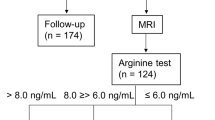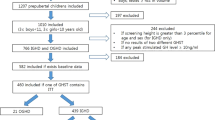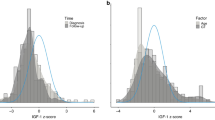Abstract
Plasma insulin-like growth factor 1 (IGF-I) concentrations are regulated by genetic factors, nutrient intake, growth hormone (GH) and other hormones such as T4, cortisol and sex steroids. The accuracy of IGF-I measurement in diagnosing GH deficiency or excess depends, in part, on the relative contributions of each of these variables. Since their respective influence may vary widely between individuals, the establishment of well-defined normal ranges is necessary, which requires adequate numbers of normal individuals, in order for IGF-I measurements to have maximum utility. In states of GH deficiency, the influence of these non-GH-related factors predominates. Although IGF-I levels have utility as a screening test in children and young adults, they cannot be used as a stand-alone test for the diagnosis of GH deficiency. By contrast, in acromegaly, GH is the predominant determinant of IGF-I levels and, therefore, measurement of IGF-I is a very useful diagnostic test. In acromegaly, IGF-I levels are useful for assessing the relative degree of GH excess, because changes in IGF-I correlate with changes in symptoms and soft-tissue growth. IGF-I is also very useful in monitoring the symptomatic response to therapy.
Key Points
-
Insulin-like growth factor 1 (IGF-I) is a useful screening test in children and young adults with growth-hormone deficiency
-
IGF-I is not a stand-alone diagnostic test for growth-hormone deficiency in adults, and a confirmatory growth-hormone-stimulation test is required
-
IGF-I can be used as a stand-alone diagnostic test for acromegaly
-
Measurement of IGF-I at the time of diagnosis in acromegaly provides useful information on disease severity
-
Monitoring the change in IGF-I levels during treatment of acromegaly provides a good index of the symptomatic response
-
Growth hormone levels after glucose suppression, and IGF-I levels, are useful predictors of treatment success in acromegaly that correlate with long-term outcome
This is a preview of subscription content, access via your institution
Access options
Subscribe to this journal
Receive 12 print issues and online access
$209.00 per year
only $17.42 per issue
Buy this article
- Purchase on Springer Link
- Instant access to full article PDF
Prices may be subject to local taxes which are calculated during checkout

Similar content being viewed by others
References
Jones JI and Clemmons DR (1995) Insulin-like growth factors and their binding proteins: biological actions. Endocr Rev 16: 3–34
Yakar S et al. (1999) Normal growth and development in the absence of hepatic insulin-like growth factor I. Proc Natl Acad Sci USA 96: 7324–7329
Thissen JP et al. (1996) Use of insulin-like growth factor-I (IGF-I) and IGF-binding protein-3 in the diagnosis of acromegaly and growth hormone deficiency in adults. Growth Regul 6: 222–229
Clemmons DR et al. (1981) Reduction of plasma immunoreactive somatomedin C during fasting in humans. J Clin Endocrinol Metab 53: 1247–1250
Isley WL et al. (1983) Dietary components that regulate serum somatomedin-C concentrations in humans. J Clin Invest 71: 175–182
Roberts CT Jr et al. (1987) Molecular cloning of rat insulin-like growth factor I complementary deoxyribonucleic acids: differential messenger ribonucleic acid processing and regulation by growth hormone in extrahepatic tissues. Mol Endocrinol 1: 243–248
Underwood LE et al. (1994) Hormonal and nutritional regulation of IGF-I and its binding proteins. Horm Res 42: 145–151
Ho KY et al. (1988) Fasting enhances growth hormone secretion and amplifies the complex rhythms of growth hormone secretion in man. J Clin Invest 81: 968–975
Snyder DK et al. (1989) Dietary carbohydrate content determines responsiveness to growth hormone in energy-restricted humans. J Clin Endocrinol Metab 69: 745–752
Hanaire-Broutin H et al. (1996) Effect of intraperitoneal insulin delivery on growth hormone binding protein, insulin-like growth factor (IGF)-I, and IGF-binding protein-3 in IDDM. Diabetologia 39: 1498–1504
Clemmons DR and Van Wyk JJ (1984) Factors controlling blood concentration of somatomedin C. Clin Endocrinol Metab 13: 113–143
Juul A (2003) Serum levels of insulin-like growth factor I and its binding proteins in health and disease. Growth Horm IGF Res 13: 113–170
Leung KC (2004) Estrogen regulation of growth hormone action. Endocr Rev 25: 693–721
Miell JP et al. (1993) Effects of hypothyroidism and hyperthyroidism on insulin-like growth factors (IGFs) and growth hormone- and IGF-binding proteins. J Clin Endocrinol Metab 76: 950–955
Juul A et al. (1995) Serum levels of insulin-like growth factor (IGF)-binding protein-3 (IGFBP-3) in healthy infants, children, and adolescents: the relation to IGF-I, IGF-II, IGFBP-1, IGFBP-2, age, sex, body mass index, and pubertal maturation. J Clin Endocrinol Metab 80: 2534–2542
Juul A et al. (1994) The ratio between serum levels of insulin-like growth factor (IGF)-I and the IGF binding proteins (IGFBP-1, 2 and 3) decreases with age in healthy adults and is increased in acromegalic patients. Clin Endocrinol (Oxf) 41: 85–93
Hong Y et al. (1996) Quantitative genetic analyses of insulin-like growth factor I (IGF-I), IGF-binding protein-1, and insulin levels in middle-aged and elderly twins. J Clin Endocrinol Metab 81: 1791–1797
Schneid H et al. (1990) Insulin-like growth factor-I gene analysis in subjects with constitutionally variant stature. Pediatr Res 27: 488–491
Vaessen N et al. (2001) A polymorphism in the gene for IGF-I: functional properties and risk for type 2 diabetes and myocardial infarction. Diabetes 3: 637–642
Arends N et al. (2002) Polymorphism in the IGF-I gene: clinical relevance for short children born small for gestational age (SGA). J Clin Endocrinol Metab 87: 2720–2724
Rosen CJ et al. (1998) Association between serum insulin growth factor-I (IGF-I) and a simple sequence repeat in IGF-I gene: implications for genetic studies of bone mineral density. J Clin Endocrinol Metab 83: 1606–1610
Frayling TM et al. (2002) A putative functional polymorphism in the IGF-I gene. Association studies with type 2 diabetes, adult height, glucose tolerance, and fetal growth in U.K. populations. Diabetes 51: 2313–2316
Miyao M et al. (1998) Polymorphism of insulin-like growth factor I gene and bone mineral density and the insulin-like growth factor I gene locus. Calcif Tissue Int 63: 306–311
Blum WF et al. (1993) Serum levels of insulin-like growth factor I (IGF-I) and IGF binding protein 3 reflect spontaneous growth hormone secretion. J Clin Endocrinol Metab 76: 1610–1616
Baxter RC (1990) Circulating levels and molecular distribution of the acid-labile α subunit of the high molecular weight insulin-like growth factor-binding protein complex. J Clin Endocrinol Metab 70: 1347–1353
Clemmons DR et al. (1991) Variables controlling the secretion of insulin-like growth factor binding protein-2 in normal human subjects. J Clin Endocrinol Metab 73: 727–733
Unterman TG (1993) Insulin-like growth factor binding protein-1: identification, purification, and regulation in fetal and adult life. Adv Exp Med Biol 343: 215–226
Rosenfeld RG et al. (1986) Insulin-like growth factors I and II in evaluation of growth retardation. J Pediatr 109: 428–433
Span JP et al. (1999) Plasma IGF-I is a useful marker of growth hormone deficiency in adults. J Endocrinol Invest 22: 446–450
Aimaretti G et al. (1998) Usefulness of IGF-I assay for the diagnosis of GH deficiency in adults. J Endocrinol Invest 21: 506–511
Rikken B et al. (1998) Plasma levels of insulin-like growth factor IGF-I, IGF-II and IGF binding protein 3 in the evaluation of childhood growth hormone deficiency. Horm Res 50: 166–176
Thissen JP et al. (1994) Nutritional regulation of the insulin-like growth factors. Endocr Rev 15: 80–101
Lissett CA et al. (2003) Determinants of IGF-I status in a large cohort of growth hormone-deficient (GHD) subjects: the role of timing of onset of GHD. Clin Endocrinol 59: 773–778
Janssen YJ et al. (1997) A low starting dose of genotropin in growth hormone-deficient adults. J Clin Endocrinol Metab 82: 129–135
Attanasio AF et al. (2002) Body composition, IGF-I and IGFBP-3 concentrations as outcome measures in severely GH-deficient (GHD) patients after childhood GH treatment: a comparison with adult onset GHD patients. J Clin Endocrinol Metab 87: 3368–3372
Hartman ML et al. (2002) Which patients do not require a GH stimulation test for the diagnosis of adult GH deficiency? J Clin Endocrinol Metab 87: 477–485
Wikland KA et al. (2000) Validated multivariate models predicting the growth response to GH treatment in individual short children with a broad range in GH secretion capacities. Pediatr Res 48: 475–484
Abs R et al. (1999) GH replacement in 1,034 growth hormone deficient hypopituitary adults: demographic and clinical characteristics, dosing and safety. Clin Endocrinol (Oxf) 50: 703–713
Chipman JJ et al. (1997) The safety profile of GH replacement therapy in adults. Clin Endocrinol (Oxf) 46: 473–481
Clemmons DR et al. (1979) Evaluation of acromegaly by radioimmunoassay of somatomedin-C. N Engl J Med 301: 1138–1142
Stoffel-Wagner B et al. (1997) A comparison of different methods for diagnosing acromegaly. Clin Endocrinol (Oxf) 46: 531–537
Trainer PJ et al. (2000) Treatment of acromegaly with the growth hormone-receptor antagonist pegvisomant. N Engl J Med 342: 1171–1177
Rieu M et al. (1982) The importance of insulin-like growth factor (somatomedin) measurements in the diagnosis and surveillance of acromegaly. J Clin Endocrinol Metab 55: 147–153
Paramo C et al. (1997) Comparative study of insulin-like growth factor-I (IGF-I) and IGF-binding protein-3 (IGFBP-3) level and IGF-I/IGFBP-3 ratio measurements and their relationship with an index of clinical activity in the management of patients with acromegaly. Metabolism 46: 494–498
Arafah BM et al. (1987) Value of growth hormone dynamics and somatomedin C (insulin-like growth factor I) levels in predicting the long-term benefit after transsphenoidal surgery for acromegaly. J Lab Clin Med 109: 346–354
Lindholm J et al. (1987) Investigation of the criteria for assessing the outcome of treatment in acromegaly. Clin Endocrinol (Oxf) 27: 553–562
Giustina A et al. (2000) Criteria for cure of acromegaly: a consensus statement. J Clin Endocrinol Metab 85: 526–529
Holdaway IM et al. (2004) Factors influencing mortality in acromegaly. J Clin Endocrinol Metab 89: 667–674
Swearingen B et al. (1998) Long-term mortality after transsphenoidal surgery and adjunctive therapy for acromegaly. J Clin Endocrinol Metab 83: 3419–3426
Biermasz NR et al. (2004) Determinants of survival in treated acromegaly in a single center: predictive value of serial insulin-like growth factor I measurements. J Clin Endocrinol Metab 89: 2789–2796
Ayuk J et al. (2004) Growth hormone and pituitary radiotherapy, but not serum insulin-like growth factor-I concentrations, predict excess mortality in patients with acromegaly. J Clin Endocrinol Metab 89: 1613–1617
Skjaerbaek C et al. (1998) Differential changes in free and total insulin-like growth factor I after major, elective abdominal surgery: the possible role of insulin-like growth factor-binding protein-3 proteolysis. J Clin Endocrinol Metab 83: 2445–2449
Lang CH et al. (1996) Regulation of the insulin-like growth factor system by insulin in burn patients. J Clin Endocrinol Metab 81: 2474–2480
Sermet-Gaudelus I et al. (2003) Insulin-like growth factor I correlates with lean body mass in cystic fibrosis patients. Arch Dis Child 88: 956–961
Congote LF (2005) Monitoring insulin-like growth factors in HIV infection and AIDS. Clin Chim Acta 361: 30–53
Waters DL et al. (2003) Serum sex hormones, IGF-1, and IGFBP3 exert a sexually dimorphic effect on lean body mass in aging. J Gerontol A Biol Sci Med Sci 58: 648–652
Ketelslegers JM et al. (1995) Nutritional regulation of insulin-like growth factor-I. Metabolism 44: 50–57
Pascal N et al. (2002) Serum concentrations of sex hormone binding globulin are elevated in kwashiorkor and anorexia nervosa but not in marasmus. Am J Clin Nutr 76: 239–244
Kratzsch J et al. (1995) Regulation of growth hormone (GH), insulin-like growth factor (IGF)I, IGF binding proteins -1, -2, -3 and GH binding protein during progression of liver cirrhosis. Exp Clin Endocrinol Diabetes 103: 285–291
Bereket A et al. (1995) Insulin-like growth factor binding protein-3 proteolysis in children with insulin-dependent diabetes mellitus: a possible role for insulin in the regulation of IGFBP-3 protease activity. J Clin Endocrinol Metab 80: 2282–2288
Strasser-Vogel B et al. (1995) Insulin-like growth factor (IGF)-I and -II and IGF-binding proteins-1, -2, and -3 in children and adolescents with diabetes mellitus: correlation with metabolic control and height attainment. J Clin Endocrinol Metab 80: 1207–1213
Wedrychowicz A et al. (2005) Insulin-like growth factor-1 and its binding proteins, IGFBP-1 and IGFBP-3, in adolescents with type-1 diabetes mellitus and microalbuminuria. Horm Res 63: 245–251
Jehle PM et al. (1998) Serum levels of insulin-like growth factor system components and relationship to bone metabolism in Type 1 and Type 2 diabetes mellitus patients. J Endocrinol 159: 297–306
Clauson PG et al. (1998) Insulin-like growth factor-I and insulin-like growth factor binding protein-1 in a representative population of type 2 diabetic patients in Sweden. Scand J Clin Lab Invest 58: 353–360
Sandhu MS et al. (2002) Circulating concentrations of insulin-like growth factor-I and development of glucose intolerance: a prospective observational study. Lancet 359: 1740–1745
Yang SW and Yu JS (2000) Relationship of insulin-like growth factor-I, insulin-like growth factor binding protein-3, insulin, growth hormone in cord blood and maternal factors with birth height and birthweight. Pediatr Int 42: 31–36
Verkauskiene R et al. (2005) Smallness for gestational age is associated with persistent change in insulin-like growth factor I (IGF-I) and the ratio of IGF-I/IGF-binding protein-3 in adulthood. J Clin Endocrinol Metab 90: 5672–5676
Woods KA et al. (2002) The somatotropic axis in short children born small for gestational age: relation to insulin resistance. Pediatr Res 51: 76–80
Brabant G et al. (2003) Serum insulin-like growth factor I reference values for an automated chemiluminescence immunoassay system: results from a multicenter study. Horm Res 60: 53–60
van den Beld AW et al. (2003) Serum insulin-like growth factor binding protein-2 levels as an indicator of functional ability in elderly men. Eur J Endocrinol 148: 627–634
Blackman MR et al. (2002) Growth hormone and sex steroid administration in healthy aged women and men: a randomized controlled trial. JAMA 288: 2282–2292
Heald A et al. (2005) Effects of hormone replacement therapy on insulin-like growth factor (IGF)-I, IGF-II and IGF binding protein (IGFBP)-1 to IGFBP-4: implications for cardiovascular risk. Gynecol Endocrinol 20: 176–182
Cook DM et al. (1999) Route of estrogen administration helps to determine growth hormone (GH) replacement dose in GH-deficient adults. J Clin Endocrinol Metab 84: 3956–3960
Nasu M et al. (1997) Effect of natural menopause on serum levels of IGF-I and IGF-binding proteins: relationship with bone mineral density and lipid metabolism in perimenopausal women. Eur J Endocrinol 136: 608–616
Keenan BS et al. (1993) Androgen-stimulated pubertal growth: the effects of testosterone and dihydrotestosterone on growth hormone and insulin-like growth factor-I in the treatment of short stature and delayed puberty. J Clin Endocrinol Metab 76: 996–1001
Soares-Welch C et al. (2005) Short-term testosterone supplementation does not activate GH and IGF-I production in postmenopausal women. Clin Endocrinol (Oxf) 63: 32–38
Veldhuis JD et al. (2005) Testosterone supplementation in healthy older men drives GH and IGF-I secretion without potentiating peptidyl secretagogue efficacy. Eur J Endocrinol 153: 577–586
Veldhuis JD et al. (2005) Testosterone blunts feedback inhibition of growth hormone secretion by experimentally elevated insulin-like growth factor-I concentrations. J Clin Endocrinol Metab 90: 1613–1617
Veldhuis JD et al. (2005) Testosterone and estradiol regulate free insulin-like growth factor I (IGF-I), IGF binding protein 1 (IGFBP-1), and dimeric IGF-I/IGFBP-1 concentrations. J Clin Endocrinol Metab 90: 2941–2917
Bang P et al. (1993) Insulin-like growth factor (IGF) I and II and IGF binding protein (IGFBP) 1, 2 and 3 in serum from patients with Cushing's syndrome. Acta Endocrinol (Copenh) 128: 397–404
Clemmons DR (2001) Commercial assays available for insulin-like growth factor I and their use in diagnosing growth hormone deficiency. Horm Res 55 (Suppl 2): 73–79
Blum WF and Breier BH (1994) Radioimmunoassays for IGFs and IGFBPs. Growth Regul 4 (Suppl 1): 11–19
Milani D et al. (2004) Variability and reliability of single serum IGF-I measurements: impact on determining predictability of risk ratios in disease development. J Clin Endocrinol Metab 89: 2271–2274
Kenyon C (2005) The plasticity of aging: insights from long-lived mutants. Cell 120: 449–460
Clemmons DR (2004) The relative roles of growth hormone and IGF-1 in controlling insulin sensitivity. J Clin Invest 113: 25–27
Freda PU et al. (2004) Significance of “abnormal” nadir growth hormone levels after oral glucose in postoperative patients with acromegaly in remission with normal insulin-like growth factor-I levels. J Clin Endocrinol Metab 89: 495–500
Dimaraki EV et al. (2002) Acromegaly with apparently normal GH secretion: implications for diagnosis and follow-up. J Clin Endocrinol Metab 87: 3537–3542
Puder JJ et al. (2005) Relationship between disease-related morbidity and biochemical markers of activity in patients with acromegaly. J Clin Endocrinol Metab 90: 1972–1978
Acknowledgements
The author thanks Ms Laura Lindsey for her help in preparing the manuscript. This work was supported by a grant (HL56580) from the National Institutes of Health.
Author information
Authors and Affiliations
Corresponding author
Ethics declarations
Competing interests
The author declares no competing financial interests.
Rights and permissions
About this article
Cite this article
Clemmons, D. Clinical utility of measurements of insulin-like growth factor 1. Nat Rev Endocrinol 2, 436–446 (2006). https://doi.org/10.1038/ncpendmet0244
Received:
Accepted:
Issue Date:
DOI: https://doi.org/10.1038/ncpendmet0244
This article is cited by
-
Risk of prevalent and incident dementia associated with insulin-like growth factor and insulin-like growth factor-binding protein 3
Molecular Psychiatry (2018)
-
Discordance between mass spectrometry and immunometric IGF-1 assay in pituitary disease: a prospective study
Pituitary (2018)
-
Human conditions of insulin-like growth factor-I (IGF-I) deficiency
Journal of Translational Medicine (2012)
-
Reduction of serum IGF-I levels in patients affected with Monoclonal Gammopathies of undetermined significance or Multiple Myeloma. Comparison with bFGF, VEGF and K-ras gene mutation
Journal of Experimental & Clinical Cancer Research (2009)
-
Leitlinie zur Diagnostik des Wachstumshormonmangels im Kindes- und Jugendalter
Monatsschrift Kinderheilkunde (2009)



